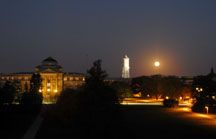Oct. 20, 2011

Photo by Bob Elbert.
$1 million marked for latest wireless project
by Diana Pounds
Students who came to campus in record numbers this fall were packing a record number of wireless devices as well. As students poured onto campus, their smart phones, laptops, netbooks, iPads and e-readers jockeyed for connections to ISU's wireless network and, ultimately, overwhelmed some university systems.
The fall rush on the network pointed to an "incredible need" for more wireless facilities, said Angela Bradley, director in information technology services (ITS).
The Computation Advisory Committee (CAC), a group that oversees spending of student technology fees, quickly allocated $1 million to add several hundred new wireless access points to high-traffic areas around campus over the next year.
First in line
Work already has begun on the project. Facilities scheduled for new access points over the next few months include College of Design and LeBaron, Curtiss and Carver halls.
"Over the course of the project, we will target all general university classrooms across campus," said Jennifer Lohrbach, ITS senior systems analyst. General classrooms are available for any classes; ISU also has classrooms reserved for departmental use.
Some classrooms that already have access points need more to handle increased loads. A single access point can accommodate up to 30 users who are actively using the Internet, Lohrbach said. A typical auditorium may require up to six access points.
"A lot of the work will be done after hours," Lohrbach add, "because these are really busy classrooms."
ITS tackles additional 300 upgrades
The $1 million CAC allocation will fund new access points in the general classrooms. Simultaneously, ITS will fund a two-year project to upgrade 300 older access points in both general and departmental classrooms and other high-demand facilities. Wireless equipment installed for both projects are built to the latest 802.11n wireless standard, which makes them faster and capable of balancing loads for more reliable service.
"The increase in wireless access on campus is important for both in-class and external activities," said Arne Hallam, associate dean in the College of Liberal Arts and Sciences and a member of CAC. "Professors are placing more and more readings and lecture materials (including lecture slides) online."
The new wireless project is the latest in a series of wireless upgrades over the past couple of years. CAC funding for recent projects also included:
- $73,000, awarded spring 2010, for 27 access points at Parks Library
- $350,000, fall 2010, for 100 access points in high-demand spots around campus
Wired campus, by the numbers
Wireless access is available in approximately 75 percent of the public areas on campus, including the Memorial Union, Parks Library and general assignment classrooms. When the latest upgrades are complete, 95 percent of the indoor public spaces and 100 percent of general assignment classrooms will be wireless.
